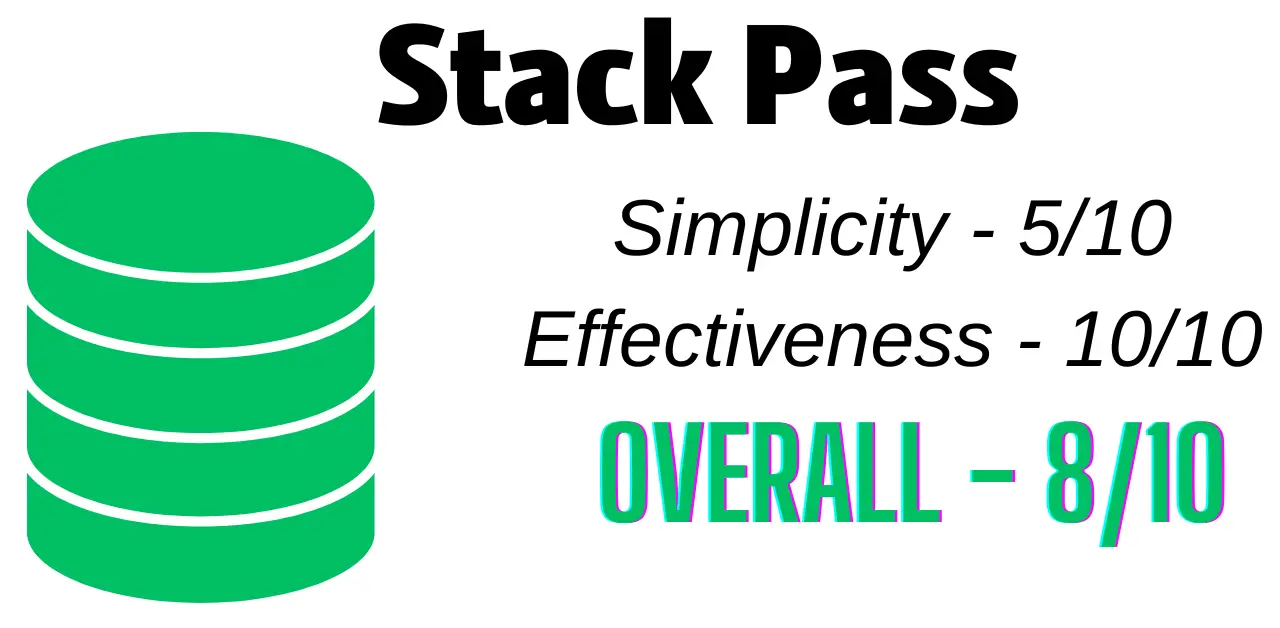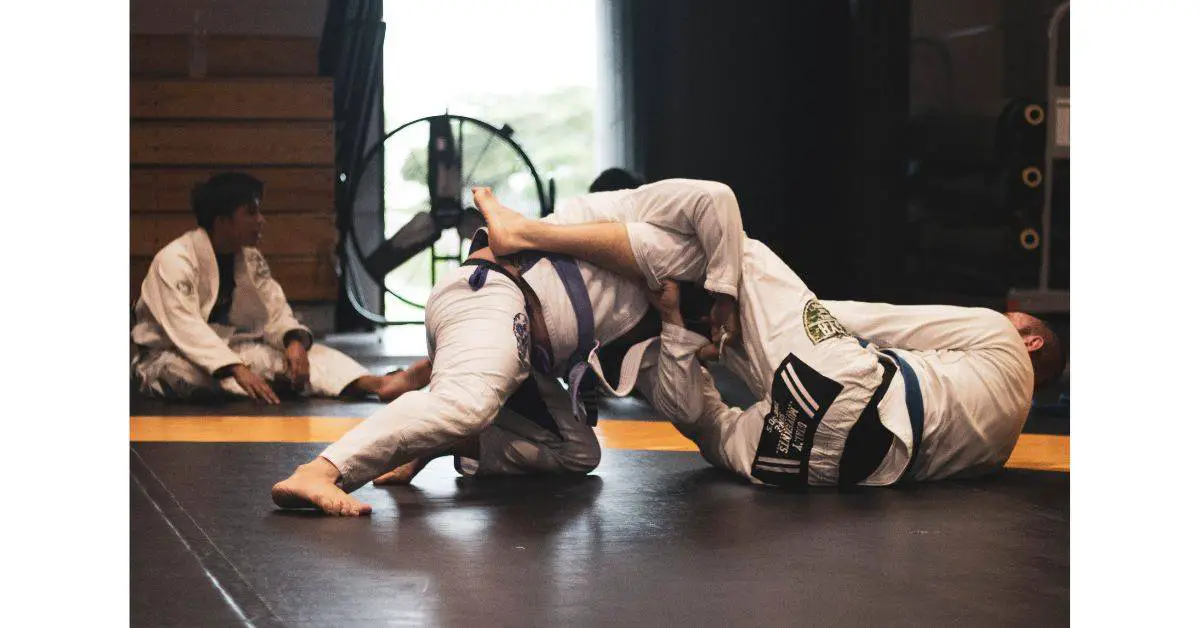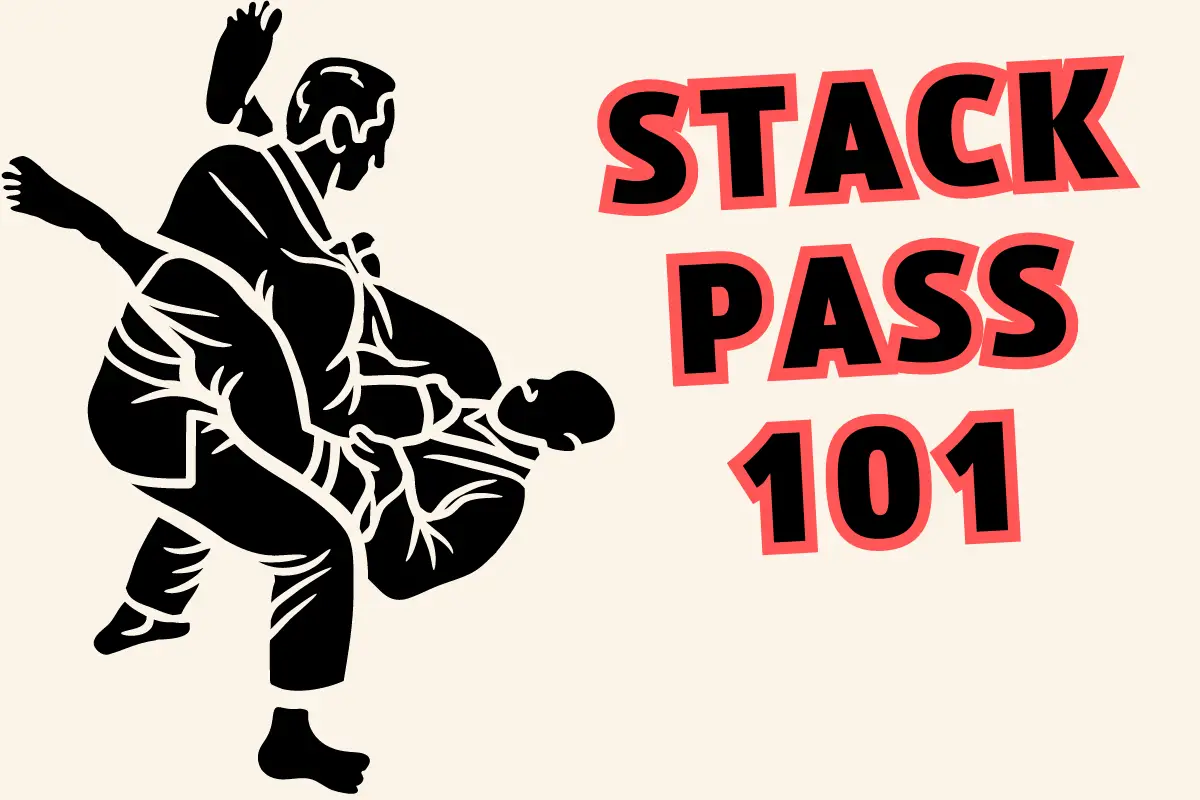The Stack pass is the most critical guard pass in BJJ. Most guard passes you’ll see today, such as the Toreando, originate from this one. Therefore, I’m a big fan of the Stack pass because it has built the foundation for Brazilian Jiu-Jitsu. So let’s see what it is and how you can perform it yourself:
The Stack pass utilizes upward pressure to go over your opponent and break his guard, attaining side control. It’s also known as the very first guard passes in BJJ; it has built the foundation for other passes, which are highly effective. The Stack pass is effective, practical, and relatively uncomplicated to execute.
However, it’s also not the simplest one you can learn. You can learn other simpler guard passes to start attaining your first few wins (if you’re a novice grappler.)
And still, I’m confident its effectiveness is as high as it gets. There’s no evading it if you’re getting technical about the small details. And this article will cover just that; the small details that will make you a fierce and powerful grappler when you use it.
I recommend you read this entire article to understand each detail (even if it’s obvious, such as starting to stand up.) You don’t understand how deep you can go with this pass to master it. So, here’s my ranking for the Stack Pass in BJJ:

Before we dive in, if you want to learn about one of the most effective guard passes in BJJ, follow the link to learn about the Toreando pass and how to pass anyone’s guard using it.
How to perform the Stack pass?
This part is perhaps the most important one. I encourage you to reread it if you don’t understand one of the steps.
And again, I recommend reading each one, as each section contains tips on performing it better. Likewise, most steps contain common mistakes you want to avoid to ensure you know how to use this excellent guard pass.
So, here it goes.
Step #1 – Start with a balanced posture
The first step is to start standing up with a balanced posture. You don’t want to lean forward or backward since that will leave you vulnerable.
Most novice grapplers would lean forward to try and control the opponent’s hips (spoiler, it’s the next step.) That’s the first mistake because advanced grapplers will utilize your imbalanced posture to ensure you fall forward and start attacking.
You want to avoid this position as much as possible.
A balanced posture means your knees are slightly bent, your spine is straight, and one of your legs steps forward. However, make sure not to lean on it.
That’s the first step. You’re now ready to advance to the 2nd one.
Step #2 – Control the opponent’s hip (by grabbing it)
The 2nd step of this Stack pass variation is to control the opponent’s hip. The best way to do it is to get closer to his body and grab it while creating downward pressure.
Regardless if you’re wearing a Gi or No-Gi, you want to create downward pressure to ensure his hips remain in place.
So, you have to apply pressure to make it happen. Don’t just grab his hips and not apply pressure since that will leave you even more vulnerable than standing slouched.
Step #3 – Stand up while creating downward pressure
Now you want to start standing up while maintaining the downward pressure on the opponent’s hips. You want to avoid standing up too fast or too slow. Go at your natural pace.
There’s one more thing you need to know:
It’s important to create downward pressure on the opponent’s hips. It’s critical you do that if you want to maintain a solid posture and an offensive position.
Ensure you keep as much control over the opponent’s body. He’ll flee from the Stack pass if you won’t have enough pressure and control.
Step #4 – Switch your hip positioning to the side
Switching your hip positioning—or weight shifting, in simpler terms—will make your opponent’s life much harder. You don’t want to face the opponent straight up. That will make his life easier.
By the way, this hip shift should be concise and powerful. That will break the opponent’s closed guard (if he hasn’t yet given up on it.)
Giving up on this step can be quite easy, as it’s not shiny. First, however, you must perform it.
Our entire goal with guard passing is to have as much control as possible. And you’ll be in a much more prominent position going forward in the fight if you have more control. Also, shifting your weight to the side will grant you a bit more power.
Step #5 – Put your elbows on your knees
The 5th step of this guard pass is to put your elbows on your knees. The opponent will try to counter your guard by flexing his legs. If you allow him to do that, you’ll be in great trouble, especially if you’re facing someone who knows what he’s doing.
This step is critical to ensure the opponent doesn’t counter your guard pass by flexing his legs. You want to block his attacks and stay on the offensive. You’ll be much more intimidating this way.
You want to step your leg forward to put your other elbow on your other knee. This will make you invincible and allow you to have all the control in the fight.
We’re almost past his guard; stay tuned for the 6th step!
Step #6 – Wrap your hand around the opponent’s leg
Now we’re getting closer and closer to passing the opponent’s guard. The 6th step (after we’ve put our elbows on our knees and blocked the opponent’s attacks) gets us back to an offensive position.
You now want to wrap your hand around the opponent’s leg, almost like an overhook. So, you want to go from the outside to the inside (don’t go for the underhook.)
The best way to do the 6th step is to wait for the opponent to try and evade your Stack pass. When you have the surprise element, you’re more likely to wrap your hands successfully. So be as unexpected as possible.
Indeed, if you can maintain the superior position by waiting for him to attack, you’ll be in a much better position.
Step #7 – Put your elbows on your quads
This step is one of the most critical ones in this guard passing process. So let’s see how that’s possible when it’s not a mandatory step to pass his guard.
This is not necessary to perform the Stack pass itself. However, it’s a fundamental step because you want to prevent the opponent from transitioning to a Triangle choke.
If the opponent successfully gets on the offensive and goes for the Triangle, you’re probably about to lose the encounter. So, it would be best if you avoided that.
The Triangle is one of the most effective BJJ moves; I wrote an article on the most effective BJJ submissions you must learn, and I encourage you to read it!
Step #8 – Lean forward and grab his lower back
The next step (after you have put your elbows on your knees to avoid the Triangle choke) is to lean forward and grab his lower back. Again, you want to hold as close as possible to his hips and tailbone to gain the most control.
Really, this is a critical step if you want to finish the Stack pass properly. You must ensure you don’t skip it, especially if you have trouble finishing guard passes.
Many novice grapplers skip these filler steps because they don’t think they’re essential. However, you can’t skip it if you want to start passing people’s guards more often.
Step #9 – Flex his legs upward
The next step will be to flex his legs upward, giving you more control over the pass.
When I first learned the Stack pass, I couldn’t understand why everyone said it was the most effective one. I wanted to understand why but couldn’t. I was convinced that evading this guard pass was easier than seems.
Nevertheless, now I understand that these filler steps, such as flexing his legs upward, give you more control. You won’t understand your power level in this guard pass until you perform it yourself.
This step leads up perfectly to the next one, turning the opponent to the side and finishing the fight.
Step #10 – Turn the opponent to the side, using your belly
You might have seen this step in the previous video. And still, we must discuss it separately. That’s the last step you will do in the Stack pass before you’re through the opponent’s guard.
I don’t know what about you, but I’m excited to have gotten thus far in the article.
Once you flex the opponent’s legs upward, you want to turn him to the side. This will lead you to gain side control. Again, you want to pressure with your belly and not your hands or legs.
Likewise, you must maintain the same level of control in the last step (9th step.) Again, the opponent will easily escape your previous steps if you allow him the space to do so.
Congratulations, you’re through the opponent’s guard. Now, it’s time to finish the move by gaining side control and going for a submission.
Step #11 – Gain side control
The last step is to gain side control. Although you’re already past his guard, I believe we must also discuss this part of the move. I know many of you have trouble finishing guard passes with a submission of some kind.
So, the first thing you want to do is gain side control. When you turn your opponent with your belly, you must immediately transition to side control while maintaining the same pressure level.
From here, you can do whatever you want. I love the side control position because you can get as creative as possible to finish the fight.
Now, I’m a big of trapping the arm and going for the Kimura grip to try and finish the fight. However, you might prefer to go for another submission, such as the Guillotine or the Armbar. It really depends on you.
Now that you know how to perform the Stack pass, I highly recommend learning more and more guard passes so that you can remain as unexpected as possible.
If you want to know how to perform the Cartwheel pass, follow the link.
Best submission after the Stack pass
The Kimura is the best submission after the Stack pass, as it transitions perfectly from side control (the position you’ll be in when you finish the guard pass.) Trapping the arm is the most effective move you can go for, leading to a potential Armbar, straight arm lock, Guillotine, and even Americana.
There’s no right and wrong in BJJ. You want to be as creative as possible to ensure the opponent doesn’t know what you’re about to perform. Do that, and you’ll be more intimidating and dangerous.
Variations of the Stack pass
This part will discuss 4 different variations of the Stack pass. I want you to understand that different teachers will teach different variations.
While there’s always a chance you’ll learn the same techniques in your BJJ gym that you have learned here, it’s more likely you’ll learn a slightly different one.
So now, let’s review the 4 types of Stacking you must know.
Single underhook Stack pass
The first variation is with using a single underhook. This is what we have learned in this article: so I’ll keep it shorter than usual.
When you lean forward, you want to underhook with only a single arm (step #6.) That will give you more control over the opponent. This step is critical because the opponent will escape if you don’t underhook the opponent.
This is what we’ve learned thus far. Now, let’s see what is different with the double underhook pass.
Double underhook Stack pass
The double under Stack pass is the same as the previous variation, with one slight difference: you want to wrap both your hands under the opponent’s hamstrings.
This variation allows more control over the opponent, making you more likely to finish the fight.
However, it’s not all pink. You can easily mess it up and allow the opponent an opening to start attacking. So it would be best if you were as quick as possible to prevent that from happening. That’s why you have to drop down exceptionally quickly.
So, how do you do that?
You drop down quickly, not by going limb after limb. Instead, you want to drop down on your knees before you begin flexing the opponent’s leg upward. Here’s how this motion looks:
Gi Stack pass
Now that we understand the difference between the single and the double underhook Stack passes let’s go on to the last two variations of this part: the Gi and the No-Gi.
I’ll keep this section relatively short, as there’s only one difference between the two: the grip. You want to grab as much material as possible when stacking with a Gi. That will allow you to create more pressure and gain more control over the opponent.
If you don’t own a Gi yet and want to own the best ones, follow the link to read about the best grappling Gi’s you should buy.
No-Gi Stack pass
Performing the No-Gi Stack isn’t so different from the Gi variation. Everything stays the same other than one detail (a somewhat important one, most would argue), your grip.
When you have a Gi on, you want to grab as much material as possible; you also have the belt to hold on to—to create more pressure onto the opponent’s hips and lower body.
However, the case is different when you don’t have one on.
To perform the No-Gi Stack Pass, you want to create as much pressure as possible over the opponent’s hips by pushing his hips down. Because you don’t have any material to hold onto, you must create as much downward pressure over his hips (this might be painful for him) to ensure you have enough control.
This part was about the different variations Stack pass has to offer. Now that we’re through, I encourage you to follow the link to learn more about another highly effective guard pass, the X pass. Likewise, follow this link to start performing the Knee Slice pass flawlessly.
When should I use the Stack pass?
Using the Stack pass when the opponent’s legs are high would be best. Because you’ll be flexing them upward, you’ll be in a better position to do so if his legs are already high. For example, if his legs are narrow and low, performing the Toreando pass would be best.

The thing with guard passing is utilizing everything you have, including the current opponent’s leg positioning.
Thus, examining his leg positioning before going for the Stack pass is best.
Is the Stack pass effective?
The Stack pass is one of BJJ’s most effective guard passes because it allows you to go over the opponent, which fewer grapplers expect. Most people expect you to go from the side, such as in the X pass. So, when you go over, you’re more likely to get through the opponent’s guard and into side control.
Should I learn the Stack pass?
While the Stack pass is more complex than other guard passes, such as the one-arm throw and the Toreando, you want to learn it as soon as possible because it’ll help you better grasp the concept of guard passing in BJJ. In addition, it’ll help you learn more passes quickly, as they all originate from it.
If you want to learn about another highly effective guard pass in BJJ, follow the link to learn about the leg drag pass.
Final words
I love guard passing in Brazilian Jiu-Jitsu. There’s no more fulfilling feeling than getting through the opponent’s defensive line and finishing the fight right there.
Learning the Stack pass will help you achieve that feeling more often because it’s incredibly effective. As a result, you’ll likely get through the opponent’s defensive line and win more fights.
But there’s one thing I didn’t tell you.
The Stack pass isn’t BJJ’s most effective guard pass. Therefore, I wrote an article on BJJ’s most effective guard passes. Make sure to follow the link to see the complete list and become a more complete grappler.

